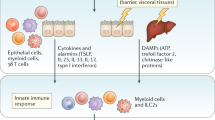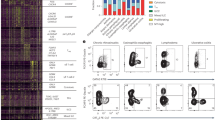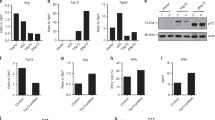Key Points
-
The T-cell immunoglobulin mucin (TIM) gene family is located on chromosome 11 in mice and 5q33 in humans. Genomic analysis has identified eight family members in mice and three in humans.
-
TIM3 is not expressed by naive or activated T cells, but is expressed by T helper 1 (TH1) cells after several rounds of polarization in vitro.
-
A locus encompassing the Tim family of genes on mouse chromosome 11 is linked to many autoimmune diseases in mice, and to airway hyperreactivity and TH2-cell pro-inflammatory responses. A syntenic region on human chromosome segment 5q33 is linked to asthma in humans.
-
The locus that regulates mouse airway hyperreactivity includes the TIM family of genes. Tim1 and Tim3 are polymorphic between mouse airway hyperreactivity-susceptible and -resistant strains of mice.
-
TIM1 was independently identified as a cellular receptor for hepatitis A virus. In humans, infection with hepatitis A virus seems to be associated with resistance to asthma and atopy indirectly. One possible explanation is that infection with hepatitis A virus might regulate the functions of TH2 cells by interacting with TIM1.
-
Semaphorin 4A (sema4A), which is expressed by B cells, macrophages and dendritic cells is the ligand for Tim2. Blockade of sema4A inhibits clonal expansion of T cells and inhibits the development of autoimmune disease in mice.
-
Engagement of TIM3 by TIM3-specific antibodies during an ongoing immune response, results in the activation and clonal expansion of macrophages, indicating that TIM3 might have a crucial role in regulating macrophages.
-
Differential expression of TIM proteins by TH1 and TH2 cells might provide a useful target to regulate the functions of effector TH1 and TH2 cells.
Abstract
The search for cell-surface markers that can distinguish T helper 1 (TH1) cells from TH2 cells has led to the identification of a new gene family, encoding the T-cell immunoglobulin mucin (TIM) proteins, some of which are differentially expressed by TH1 and TH2 cells. The role of the TIM-family proteins in immune regulation is just beginning to emerge. Here, we describe the various TIM-family members in mice and humans, and discuss the genetic and functional evidence for their role in regulating autoimmune and allergic diseases.
This is a preview of subscription content, access via your institution
Access options
Subscribe to this journal
Receive 12 print issues and online access
$209.00 per year
only $17.42 per issue
Buy this article
- Purchase on Springer Link
- Instant access to full article PDF
Prices may be subject to local taxes which are calculated during checkout






Similar content being viewed by others
References
Mosmann, T. R., Cherwinski, H., Bond, M. W., Giedlin, M. A. & Coffman, R. L. Two types of murine helper T cell clone. I. Definition according to profiles of lymphokine activities and secreted proteins. J. Immunol. 136, 2348–2357 (1986). T-cell clones derived from mice after activation produce different patterns of cytokines that are mutually exclusive. Whereas T helper 1 (T H 1) cells produce interleukin-2 (IL-2) and interferon-γ (IFN-γ), T H 2 cells produce IL-4. This led to the definition of T H 1- and T H 2-cell subsets.
Mosmann, T. R. & Coffman, R. L. TH1 and TH2 cells: different patterns of lymphokine secretion lead to different functional properties. Annu. Rev. Immunol. 7, 145–173 (1989).
Abbas, A. K., Murphy, K. M. & Sher, A. Functional diversity of helper T lymphocytes. Nature 383, 787–793 (1996).
Sher, A. & Coffman, R. L. Regulation of immunity to parasites by T cells and T cell-derived cytokines. Annu. Rev. Immunol. 10, 385–409 (1992).
Kuchroo, V. et al. B7-1 and B7-2 costimulatory molecules differentially activate the TH1/TH2 developmental pathways: application to autoimmune disease therapy. Cell 80, 707–716 (1995).
Loetscher, P. et al. CCR5 is characteristic of TH1 lymphocytes. Nature 391, 344–345 (1998).
Bonecchi, R. et al. Differential expression of chemokine receptors and chemotactic responsiveness of type 1 T helper cells (TH1s) and TH2s. J. Exp. Med. 187, 129–134 (1998).
Sallusto, F., Lenig, D., Mackay, C. R. & Lanzavecchia, A. Flexible programs of chemokine receptor expression on human polarized T helper 1 and 2 lymphocytes. J. Exp. Med. 187, 875–883 (1998). References 6, 7 and 8 describe the differential expression of chemokine receptors on the cell surface of human T H 1 and T H 2 cells. As cells differentiate along the T H 1- or T H 2-cell pathway, they acquire expression of a specific combination of chemokine receptors on the cell surface.
Venkataraman, C., Schaefer, G. & Schindler, U. Cutting edge: chandra, a novel four-transmembrane domain protein differentially expressed in helper type 1 lymphocytes. J. Immunol. 165, 632–636 (2000).
Monney, L. et al. TH1-specific cell surface protein Tim-3 regulates macrophage activation and severity of an autoimmune disease. Nature 415, 536–541 (2002). This study reported the generation of two monoclonal antibodies that can stain T H 1 but not T H 2 cells. Expression cloning identified a new molecule, known as T-cell immunoglobulin mucin 3 (TIM3) that is specifically expressed by T H 1 cells. Treatment with antibody specific for TIM3 worsened experimental autoimmune encephalomyelitis (EAE) and led to increased macrophage activation.
Ichimura, T. et al. Kidney injury molecule-1 (KIM-1), a putative epithelial cell adhesion molecule containing a novel immunoglobulin domain, is up-regulated in renal cells after injury. J. Biol. Chem. 273, 4135–4142 (1998). This study identified the human gene TIM1 , also known as kidney injury molecule 1 ( KIM1 ), and showed that it is expressed at high levels by ischaemic kidneys.
Han, W. K., Bailly, V., Abichandani, R., Thadhani, R. & Bonventre, J. V. Kidney injury molecule-1 (KIM-1): a novel biomarker for human renal proximal tubule injury. Kidney Int. 62, 237–244 (2002).
Feigelstock, D., Thompson, P., Mattoo, P., Zhang, Y. & Kaplan, G. G. The human homolog of HAVcr-1 codes for a hepatitis A virus cellular receptor. J. Virol. 72, 6621–6628 (1998). This paper shows that TIM1 is a receptor for hepatitis A virus.
Feigelstock, D., Thompson, P., Mattoo, P. & Kaplan, G. G. Polymorphisms of the hepatitis A virus cellular receptor 1 in African green monkey kidney cells result in antigenic variants that do not react with protective monoclonal antibody 190/4. J. Virol. 72, 6218–6222 (1998).
Kaplan, G. et al. Identification of a surface glycoprotein on African green monkey kidney cells as a receptor for hepatitis A virus. EMBO J. 15, 4282–4296 (1996).
McIntire, J. J. et al. Identification of Tapr (an airway hyperreactivity regulatory locus) and the linked Tim gene family. Nature Immunol. 2, 1109–1116 (2001). Using a congenic mouse strain on the BALB/c background, this study identified a locus on chromosome 11 that provided resistance to allergen-induced airway hyperreactivity (AHR). By reducing the congenic interval, the study excluded the Il4 -gene family but included the Tim -gene family in the interval. The authors also showed that there were polymorphisms in Tim1 and Tim3 genes in the AHR-susceptible and -resistant strains of mice.
Butcher, E. C. & Picker, L. J. Lymphocyte homing and homeostasis. Science 272, 60–66 (1996).
Bailly, V. et al. Shedding of kidney injury molecule-1, a putative adhesion protein involved in renal regeneration. J. Biol. Chem. 277, 39739–39748 (2002). The authors showed that TIM1 is shed as a result of cleavage by a metalloproteinase and that there are tissue-specific splice variants of TIM1 that have or lack the tyrosine-kinase phosphorylation motif.
Kumanogoh, A. et al. Class IV semaphorin Sema4A enhances T-cell activation and interacts with Tim-2. Nature 419, 629–633 (2002). This study identified semaphorin 4A (sema4A) as the ligand for mouse Tim2. Antibodies specific for sema4A resulted in the inhibition of T-cell proliferative responses and cytokine production, and blocked the development of EAE in mice.
Encinas, J. A. & Kuchroo, V. K. Mapping and identification of autoimmunity genes. Curr. Opin. Immunol. 12, 691–697 (2000).
Encinas, J. A. et al. QTL influencing autoimmune diabetes and encephalomyelitis map to a 0.15-cM region containing Il2. Nature Genet. 21, 158–160 (1999).
Bergsteinsdottir, K., Yang, H. T., Pettersson, U. & Holmdahl, R. Evidence for common autoimmune disease genes controlling onset, severity, and chronicity based on experimental models for multiple sclerosis and rheumatoid arthritis. J. Immunol. 164, 1564–1568 (2000).
Daniels, S. E. et al. A genome-wide search for quantitative trait loci underlying asthma. Nature 383, 247–250 (1996).
Ober, C. et al. Genome-wide search for asthma susceptibility loci in a founder population. The collaborative study on the genetics of asthma. Hum. Mol. Genet. 7, 1393–1398 (1998).
Wjst, M. et al. A genome-wide search for linkage to asthma. German Asthma Genetics Group. Genomics 58, 1–8 (1999).
Van Eerdewegh, P. et al. Association of the ADAM33 gene with asthma and bronchial hyperresponsiveness. Nature 418, 426–430 (2002).
Postma, D. S. et al. Genetic susceptibility to asthma — bronchial hyperresponsiveness coinherited with a major gene for atopy. N. Engl. J. Med. 333, 894–900 (1995).
Ober, C. et al. Variation in the interleukin 4-receptor α gene confers susceptibility to asthma and atopy in ethnically diverse populations. Am. J. Hum. Genet. 66, 517–526 (2000).
Yokouchi, Y. et al. Significant evidence for linkage of mite-sensitive childhood asthma to chromosome 5q31–q33 near the interleukin 12 B locus by a genome-wide search in Japanese families. Genomics 66, 152–160 (2000).
Hershey, G. K., Friedrich, M. F., Esswein, L. A., Thomas, M. L. & Chatila, T. A. The association of atopy with a gain-of-function mutation in the α subunit of the interleukin-4 receptor. N. Engl. J. Med. 337, 1720–1725 (1997).
Hargreave, F. E. et al. Bronchial responsiveness to histamine or methacholine in asthma: measurement and clinical significance. J. Allergy Clin. Immunol 68, 347–355 (1981).
Potter, M. et al. A BALB/c congenic strain of mice that carries a genetic locus (Ityr) controlling resistance to intracellular parasites. Infect. Immun. 40, 1234–1235 (1983).
Ruscetti, S., Matthai, R. & Potter, M. Susceptibility of BALB/c mice carrying various DBA/2 genes to development of friend murine leukemia virus-induced erythroleukemia. J. Exp. Med. 162, 1579–1587 (1985).
Potter, M., Mushinski, E. B., Wax, J. S., Hartley, J. & Mock, B. A. Identification of two genes on chromosome 4 that determine resistance to plasmacytoma induction in mice. Cancer Res. 54, 969–975 (1994).
Noguchi, E. et al. Insertion/deletion coding polymorphisms in hHAVcr-1 are not associated with atopic asthma in the Japanese population. Genes Immun. 4, 170–173 (2003).
Matricardi, P. M. et al. Cross sectional retrospective study of prevalence of atopy among Italian military students with antibodies against hepatitis A virus. BMJ 314, 999–1003 (1997).
Matricardi, P. M., Rosmini, F., Panetta, V., Ferrigno, L. & Bonini, S. Hay fever and asthma in relation to markers of infection in the United States. J. Allergy Clin. Immunol. 110, 381–387 (2002).
Holgate, S. T. The epidemic of allergy and asthma. Nature 402, B2–B4 (1999).
Wu, C. et al. SAP controls T cell responses to virus and terminal differentiation of TH2 cells. Nature Immunol. 2, 410–414 (2001).
Tatsuo, H., Ono, N., Tanaka, K. & Yanagi, Y. SLAM (CDw150) is a cellular receptor for measles virus. Nature 406, 893–897 (2000).
Ling, V. et al. Cutting edge: identification of GL50, a novel B7-like protein that functionally binds to ICOS receptor. J. Immunol. 164, 1653–1657 (2000).
Chabas, D. et al. The influence of the proinflammatory cytokine, osteopontin, on autoimmune demyelinating disease. Science 294, 1731–1735 (2001).
Anjos, S., Nguyen, A., Ounissi-Benkalha, H., Tessier, M. C. & Polychronakos, C. A common autoimmunity predisposing signal peptide variant of the cytotoxic T-lymphocyte antigen 4 results in inefficient glycosylation of the susceptibility allele. J. Biol. Chem. 277, 46478–46486 (2002).
Cohn, L., Homer, R. J., Marinov, A., Rankin, J. & Bottomly, K. Induction of airway mucus production By T helper 2 (TH2) cells: a critical role for interleukin 4 in cell recruitment but not mucus production. J. Exp. Med. 186, 1737–1747 (1997).
Acknowledgements
We would like to thank D. Schlesinger and J. McIntire for their valuable help in computer searches and input to the manuscript.
Author information
Authors and Affiliations
Corresponding author
Glossary
- EXPERIMENTAL AUTOIMMUNE ENCEPHALOMYELITIS
-
(EAE). An experimental model for the human disease multiple sclerosis (MS). Autoimmune disease is induced in experimental animals by immunization with myelin antigen or peptides derived from myelin. The animals develop a paralytic disease with inflammation and demyelination in the brain and spinal cord.
- SYNTENY
-
Colinearity in the order of genes (or of other DNA sequences) in a chromosome region of two species.
- RGD MOTIF
-
A peptide motif that consists of the amino acids arginine, glycine and aspartic acid, and is found in many ligands that bind integrins.
- ALLERGEN-INDUCED AIRWAY HYPERREACTIVITY
-
(AHR). An experimental model of human allergic asthma in which mice are first sensitized to, then challenged with, allergen. This leads to airway hyperreactivity, a cardinal feature of asthma in humans.
- EPISTASIS
-
An interaction between non-allelic genes, such that one gene masks, interferes with or enhances the expression of the other gene.
- TC1 CELLS
-
CD8+ T cells that produce T helper 1 cytokines, particularly interferon-γ.
Rights and permissions
About this article
Cite this article
Kuchroo, V., Umetsu, D., DeKruyff, R. et al. The TIM gene family: emerging roles in immunity and disease. Nat Rev Immunol 3, 454–462 (2003). https://doi.org/10.1038/nri1111
Issue Date:
DOI: https://doi.org/10.1038/nri1111
This article is cited by
-
Knockdown of ELF4 aggravates renal injury in ischemia/reperfusion mice through promotion of pyroptosis, inflammation, oxidative stress, and endoplasmic reticulum stress
BMC Molecular and Cell Biology (2023)
-
Inhibition of T cell immunoglobulin and mucin-1 (TIM-1) protects against cerebral ischemia-reperfusion injury
Cell Communication and Signaling (2019)
-
T cell co-stimulation and co-inhibition in cardiovascular disease: a double-edged sword
Nature Reviews Cardiology (2019)
-
Diagnostic role of kidney injury molecule-1 in renal cell carcinoma
International Urology and Nephrology (2019)
-
Dynamic variation of kidney injury molecule-1 mRNA and protein expression in blood and urine of renal transplant recipients: a cohort study
Clinical and Experimental Nephrology (2019)



